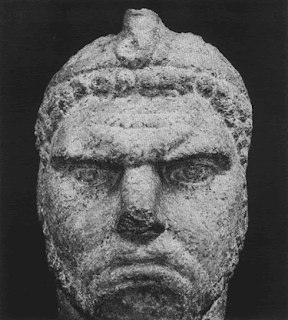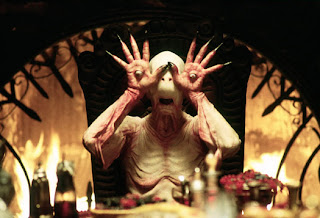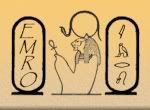Wednesday, February 28, 2007
Picasso's Paintings Stolen from Granddaughter's Home
"PARIS, Feb. 28, 2007— Two paintings by Pablo Picasso worth a total of $65 million were stolen from the Paris home of the artist's granddaughter, police said Wednesday.
The works, a painting of Picasso's daughter called Maya with Doll and a portrait of his second wife Jacqueline, were stolen in the night of Monday to Tuesday from Diana Widmaier Picasso's flat in Paris' up-market seventh district." ...more.
Tuesday, February 27, 2007
The Lost Tomb of Jesus
on the Discovery Channel,
Sunday, March 4, 8:00 p.m. Central Time
The trailer for The Lost Tomb of Jesus
"Since the 1970s, hundreds of tombs and thousands of ossuaries (limestone bone boxes) have been discovered in the Jerusalem area. These ossuaries served as coffins in first-century Jerusalem.
One of these tombs was found to contain ten ossuaries. Six of the ossuaries in this tomb have inscriptions on them. As it turns out, every inscription in this particular tomb relates to the Gospels.
In the feature documentary The Lost Tomb of Jesus a case is made that the 2,000-year-old "Tomb of the Ten Ossuaries" belonged to the family of Jesus of Nazareth.
All leading epigraphers agree about the inscriptions. All archaeologists confirm the nature of the find. It comes down to a matter of statistics. A statistical study commissioned by the broadcasters (Discovery Channel/Vision Canada/C4 UK) concludes that the probability factor is 600 to 1 in favor of this tomb being the tomb of Jesus of Nazareth and his family.
The film also documents DNA extraction from human residue found in two of the ossuaries and reveals new evidence that throws light on Jesus' relationship with Mary Magdalene.
The documentary includes dramatic recreations, based on the latest historical evidence, illustrating accurate images of Jesus of Nazareth, his family, his followers, his ministry, his crucifixion and his entombment.
Part archaeological adventure, part Biblical history, part forensic science, part theological controversy: this is a story that will be carried around the world." (1)
Links:
Discovery Channel Companion Website
Video Interviews with the Filmmakers
Official Website
(1) From "About the Show" on the Discovery Channel companion website.
Tuesday, February 20, 2007
It's Electric!
Friday, February 16, 2007
ART CLASSIC #2
Artist Unknown
Early 3rd Century CE
Marble 14 1/2 "
The Metropolitan Museum of Art, NY
 Click on picture to enlarge.
Click on picture to enlarge.The year 212 saw a flurry of administrative reforms under the young emperor's leadership. Soldiers received increases in pay and in legal rights, but the most noteworthy change was the bestowal of Roman citizenship upon all free residents of the empire. This grant of universal citizenship, called by scholars the Constitutio Antoniniana, allowed for greater standardization in the increasingly bureaucratic Roman state. Construction was also well underway on the magnificant baths in Rome that would bear the emperor's name. The main building seems to have been completed four years later, but the entire complex was not finished until the reign of Alexander Severus.
Caracalla spent little time in Rome after the spring of 213. A visit to Gaul and a military campaign along the borders of Upper Germany and Raetia occupied much of the rest of the year. Winter may have been spent in Rome, but the following year Caracalla made a journey to the East in preparation for a war against the Parthians. Along the way, the emperor displayed an increasing fascination and identification with Alexander the Great. Like the Macedonian prince, however, Caracalla would not survive an expedition to the East.(1)
He was assassinated in Edessa on April 8, 217 AD.
There's Caracalla's back story. The portrait above is an Art Classic. Romans strove toward realism (verism) in portraits--warts and all, and were particularly adept at capturing personality and character. That is what makes the above bust a striking portrait.
There are many portraits of Caracalla in busts, paintings, and coins. Comparing a few will reveal just what a striking and probably extremely accurate portrait this is.
First, there is the portrait of him on the Severan Tondo (with his brother deliberately wiped out on the bottom left):

Here he is a child but it is a portrait of a "knowing child." He wears a crown and a determined and ambitious gaze compared to the tender gazes of his parents. Pay particular attention to his gaze and brow line.
Here is a bust of Caracalla from Egypt:

This one is obviously more of a conceptual image or caricature and not veristic, but the attitude is there. His frown is exaggerated, but once again, one must look at this subject's gaze and brow ridge. This is an ambitious man who means business. He isn't idealized as Augustus preferred himself to be portrayed to convey a sense of immortality.
Below is a coin struck with his image in profile. Though the source of his nickname is disputed, one can see the type of cloak he wore in this image. He still possesses the strength and focus of a man with a disciplined military background.
Let's return to the subject of this Art Classic -- the bust from the third century now in the Metropolitan Museum of Art. Aside from the extreme verism of the portrait, what is compelling about this image is the personality of the sitter. This is a serious and determined man. He is rugged and stern. His hair is imbued with tension as the tight curls are close-cropped to his head and worn almost as a helmut. His chin is strong and the turn of his neck convinces us that he's turned to look at us, though we know he's just a marble bust--and we are intimidated. There is an extreme tension and strong potential energy to this piece. What is most compelling is his gaze.

His brow is furrowed and his eyes focused and intense. The artist took great care in shaping his eyes, carving the irises and pupils, as well as directing his gaze. It almost looks as if the subject sat for the sculptor. While the other images in this entry capture aspects of Caracalla and show his development in representational or conceptual ways, this bust is a real presence that imposes itself on us.
Source
(1) http://www.roman-emperors.org/caracala.htm
© Stephanie Lewis, 2007
Wednesday, February 14, 2007
The Color Red
Sunday, February 11, 2007
Curiouser and Curiouser

Another Thomas Eakins painting, The Cello Player sold last week in a secret deal after Alice Walton and the National Gallery lost their bid to purchase his painting, The Gross Clinic. Some are calling it a "tradeoff," though they insist they don't know the buyer of The Cello Player. Hmmmmm.
Friday, February 09, 2007
Did Charles Moulton Know About this Image?
 I found the image on the Springfield Museums website. Here's the website's description of the image:
I found the image on the Springfield Museums website. Here's the website's description of the image:"The Star Spangled Banner, no date
Nathaniel Currier
Hand-colored lithograph
The Star-Spangled Banner, a song written by Francis Scott Key in 1814, was a popular tune during the 19th century, especially at 4th of July celebrations. Though not recognized officially as the national anthem until 1931, Currier & Ives created two different allegorical portraits of freedom using the title of the song as their inspiration. Here, Lady Liberty wears a tiara with a shield bearing the stars and stripes and a veil decorated with stars. She carries the American flag as she strides forward toward liberty. Several phrases from the song emphasize the patriotic nature of the print:
O! long may it wave,
O'er the land of the free,
And the home of the brave"
The resemblance of this Currier and Ives lithograph of Lady Liberty is uncannily similar to that jewel of Americana--Wonder Woman. I wonder what sort of art research, the creator of Wonder Woman, Charles Moulton did to come up with the Amazon's garb. Does anyone else see a striking similarity?
Thursday, February 08, 2007
Storytelling:
Shoutout to My English Teacher Peeps

This past weekend, I saw Pan's Labyrinth. I considered reviewing it here in my blog, but it's just too amazing for words, frankly. It has made me preoccupied with an issue, however. A few years
 ago, I read the book by Dr. Clarissa Pinkola Estes, Women Who Run With the Wolves. A large part of the book is dedicated to discussing the old faerie tales (Brothers Grimm, et. al.) and how they were mostly cautionary tales for girls so that they had a mythology to prepare themselves for life as women--to navigate that sometimes dangerous world.* Estes pointed out that modern faerie tales have been "sanitized for our protection," mainly through the efforts of Disney. Girls, and boys as well, have been subsequently left in the dark about the dangers of life, because they lack the coded language of myths, fables, and faerie tales. Stories are painstakingly prepared so that they DON'T scare children, out of fear of traumatizing them. We have a movie rating
ago, I read the book by Dr. Clarissa Pinkola Estes, Women Who Run With the Wolves. A large part of the book is dedicated to discussing the old faerie tales (Brothers Grimm, et. al.) and how they were mostly cautionary tales for girls so that they had a mythology to prepare themselves for life as women--to navigate that sometimes dangerous world.* Estes pointed out that modern faerie tales have been "sanitized for our protection," mainly through the efforts of Disney. Girls, and boys as well, have been subsequently left in the dark about the dangers of life, because they lack the coded language of myths, fables, and faerie tales. Stories are painstakingly prepared so that they DON'T scare children, out of fear of traumatizing them. We have a movie rating system that sometimes seems rather arbitrary and based on "bad words" and not bad ideas. Whereas the old faerie tales taught girls to protect themselves, make wise decisions, and essentially be the heroines of their own lives, modern stories make them depend on an external rescuer. My questions are the following: What thing(s) in Western culture in particular have/has changed that a lot of parents want to shelter their children from scary stories? Do you think it is important to tell myths to children (scary and non-scary)? Why? Where do you draw the line if you tell a child a scary story? When it becomes gratuitous and without any instructional value? Somewhere else? Can your recommend any contemporary children's literature that fulfills the old role of the classic cautionary tales?
system that sometimes seems rather arbitrary and based on "bad words" and not bad ideas. Whereas the old faerie tales taught girls to protect themselves, make wise decisions, and essentially be the heroines of their own lives, modern stories make them depend on an external rescuer. My questions are the following: What thing(s) in Western culture in particular have/has changed that a lot of parents want to shelter their children from scary stories? Do you think it is important to tell myths to children (scary and non-scary)? Why? Where do you draw the line if you tell a child a scary story? When it becomes gratuitous and without any instructional value? Somewhere else? Can your recommend any contemporary children's literature that fulfills the old role of the classic cautionary tales?Top image: from Pan's Labyrinth
Inset images: by Gustave Dore
© Stephanie Lewis, 2007
Thursday, February 01, 2007
Pan's Labyrinth
I heard this fantastic interview on NPR's Fresh Air about a week ago. I highly recommend listening to this insightful interview with the director, Guillermo Del Toro. The film is up for six Academy Awards this year.







